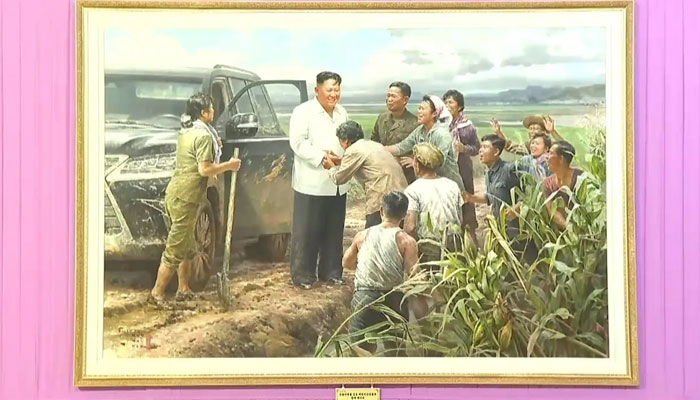A North Korean art exhibition on Friday unveiled the first paintings of Kim Jong Un, promoting his “cult of personality,” with each piece depicting outlandish or romantic visions of supreme leaders engaged in activities, such as glad-handing farmers and riding a horse on Mount Paektu.
The paintings, part of an exhibit celebrating the 70th anniversary of the “victory in the Fatherland Liberation War,” — the name used in North Korea to remember the signing of the Korean Armistice Agreement that marked the end of the Korean War in 1953 — were displayed alongside paintings of Kim’s predecessors, Kim Il Sung and Kim Jong Il.
The official opening ceremony for the exhibit was attended by Choe Chang Hak, vice department director of the Central Committee of the Workers’ Party of Korea and Choe Hui Thae, chairman of the Pyongyang Municipal People’s Committee along with officials of ministries, national institutions and creators in the field of fine art.
The exhibition attracted hundreds of locals, with Kim Jong Un’s painting prominently displayed, suggesting a possible shift in propaganda policy.
The Democratic People’s Republic of Korea (DPKR) founder Kim Il Sung and Kim Jong Il were previously displayed before Kim Jong Un, whose photographs hung third in the order, NK News reported.
The paintings show “one victory after another in the confrontation with imperialism and the US that have lasted for centuries,” according to the state-owned Korean Central News Agency (KCNA).
North Korea was formed after World War II and Japan’s surrender in 1910.
The Soviet Union occupied the area north of the 38th parallel, which was the demarcation between North and South Korea forming the demilitarised zone (DMZ) in 1953.
KCNA Watch reports that the artwork would remind visitors of Kim Jong Il’s revolutionary history and the tradition of war victory, alongside paintings of Kim Jong Un.
Additionally, the paintings depict the daily transformation of Korea under the Central Committee of the Great Workers’ Party of Korea, presenting a narrative of positive change amid a severe crisis such as starvation and the coronavirus pandemic.
As people began to prefer death over slow-starvation and suffering, Kim Jong Un declared suicide an “act of treason against socialism.”
The Times UK revealed that the identities of the artists who created Kim Jong Un’s paintings remain unknown while referring to Kim’s personal court as “opaque” and difficult to read.
Prior to the exhibit, artists in the country were prohibited from painting Kim, but restrictions were lifted, and he recently commissions three mosaic murals for public display.
Kim Jong Un’s attempt to display public works mirrors his father and grandfather’s early reigns, with portraits and statues being made public in the early years of their reign.
While no statues of Kim Jong Un have been observed yet, additional paintings include depictions of recent missile tests and military parades.
 Jago Times "English Edition" Best Online Newspaper
Jago Times "English Edition" Best Online Newspaper
